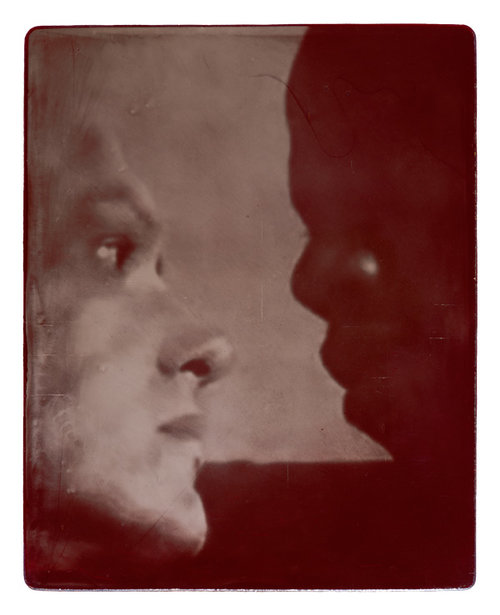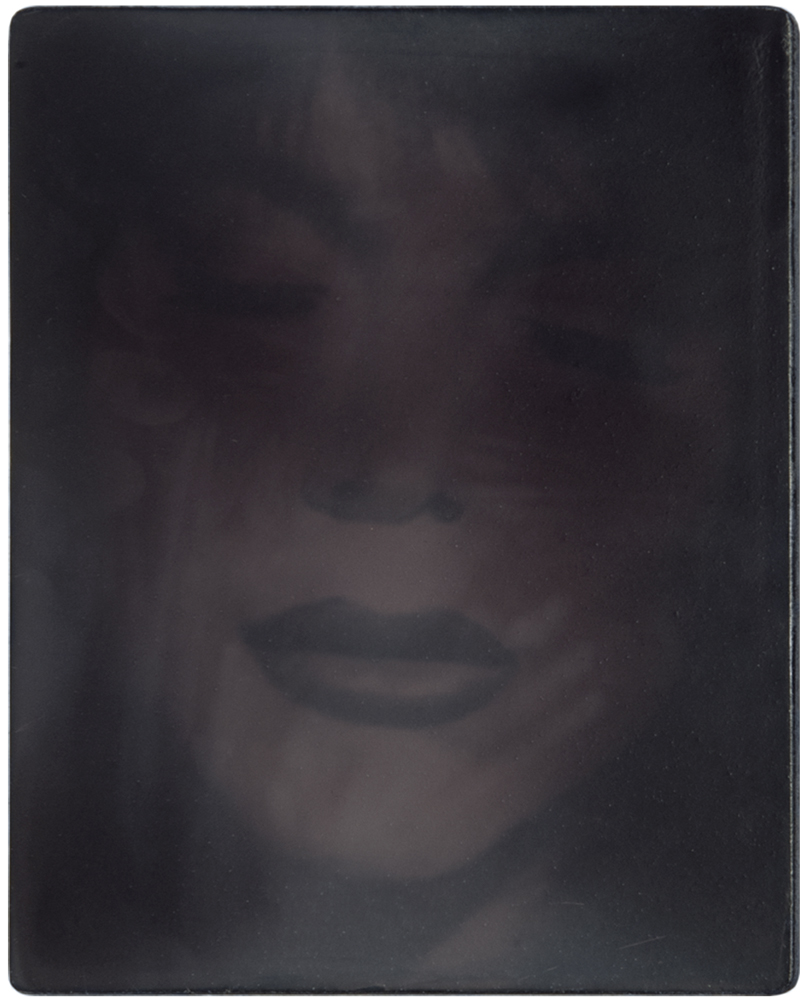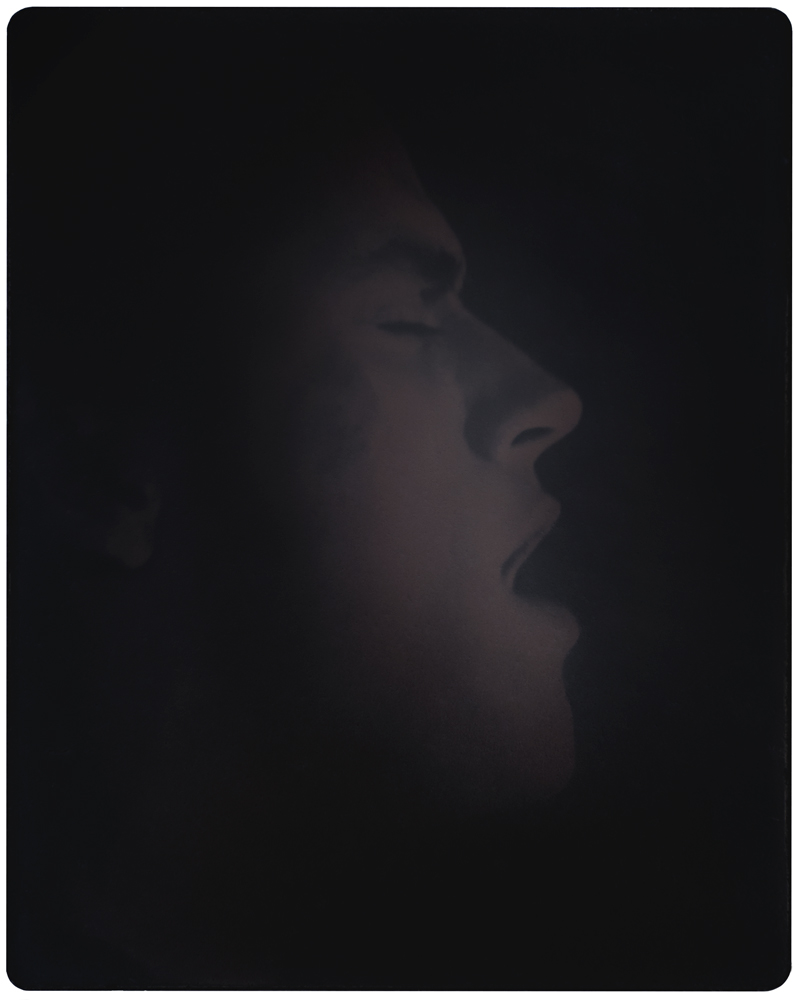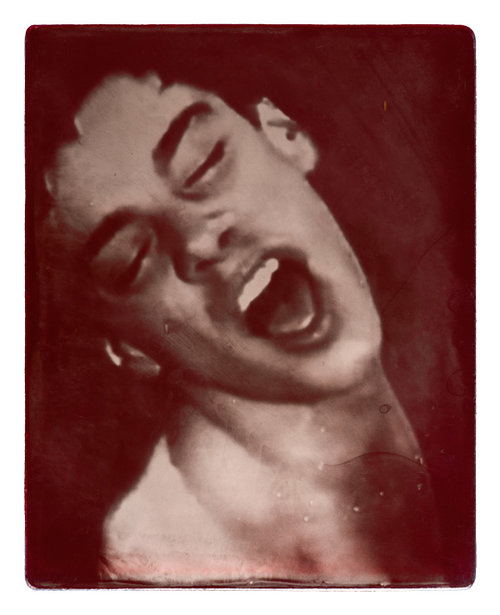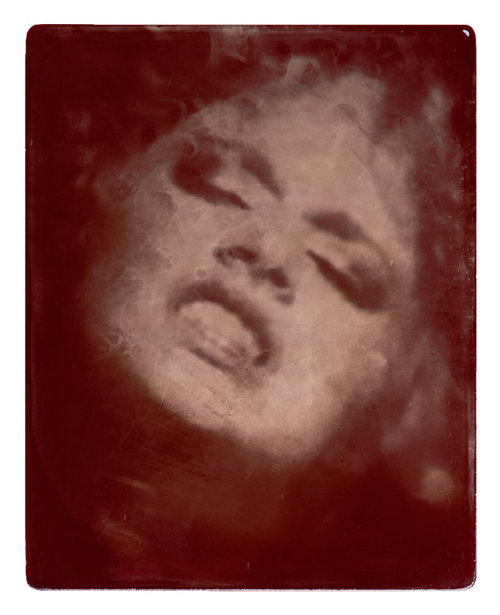Q&A: Brian Ganter
By Hamidah Glasgow | November 29, 2018
Brian Ganter (b. 1984, Helena, MT) is an artist based in Tucson, Arizona. His recent work focuses on the ephemerality of the pornographic image and body through the use of alternative photographic printing methods. His interests in human sexuality, HIV/AIDS, and custom photo emulsions stem from years of working in the healthcare field as a medical and laboratory assistant. After completing a BFA from Arizona State University, he went on to obtain an MFA from the University of Arizona. In addition to his art practice, he is an adjunct instructor at the University of Arizona and Pima Community College, as well as, the curatorial department coordinator for the Center for Creative Photography.
kiss, stroke, grip is a collection of images depicting actors who died from AIDS related complications. Transformed from porn stars into legends as a result of their deaths, the performers continue to live as hours of footage preserved within a vast and disorganized archive. These ephemeral beings are designed for consumption and only recalled when needed. For a moment, their highly stigmatized bodies are embraced.
A single film still was selected from each actor’s filmography and printed on black stained glass using wet plate collodion. The resulting ambrotypes were hidden underneath a coating of thermochromic pigment that appears black at room temperature. With the introduction of heat, the pigment becomes transparent, thereby revealing the image hidden below. In addition to using the heated platform, viewers are encouraged to touch, embrace, rub, or breathe on the plate’s surface. However, once the heat source is removed the image will slowly fade away as the plate cools.
Hamidah Glasgow: How did you start this project, kiss,stroke, grip? What was the impetus?
Brian Ganter: Leading up to kiss, stroke, grip, I was exploring my personal archive, as well as those of online communities, specifically Craigslist casual encounter ads. Here were my neighbors opening themselves up to anyone who clicked on their ad. Some described their immediate sexual desires, while others used their posting as if it were a confessional - the one ad that has stayed with me was a young man wanting to find someone who could love him and overlook an STI he had. Using wet plate and traditional darkroom printing, I created artists books and ambrotypes that paired the text of the message with any imagery the user uploaded. The resulting objects were meant to be touched, to be stroked, to be held.
During the period in which I was making this work, I received an email from a friend with the subject "Bad news." The message simply read, "Warren died today. Likely from complications from AIDS...Sent from my iPad." I didn't know Warren all that well, but the message was such a bizarre combination of brevity, guessing the cause of death, and the default email signature, that it prompted a line of research that resulted in me stumbling across online lists of pornographic performers who died from AIDS related complications. Some were informal blog posts that merely listed names. Others, like the "dead porn stars" page on the Internet Adult Film Database, were quite detailed with the cause of death, exact date of death, and quotes or articles to support the data. Using these online resources, I began researching individuals, porn studios, and filmographies. Along the way I collected screenshots of performers who died of AIDS related complications from all of this classic porn, and started to reproduce them using wet plate, albumen, and other alternative printing methods. I eventually settled on ambrotypes.
HG: I love the temperature sensitive nature of the work. The way it replicates the human experience of closeness and separation. How did the work progress to this end?
BG: I had discovered thermochromic pigment months before I began experimenting with pornographic imagery. I couldn't think of a good use for it at the time, so I just set it aside and kind of forgot about it. Not until I started reproducing film stills as ambrotypes, did I bring the heat sensitive pigment together with the images of deceased porn stars. So, I completely covered the ambrotypes with a thick layer of black heat-sensitive pigment, thereby requiring the plate to be warmed up in order to see the image hidden below. Additionally, I sand-blasted the reverse of the plate, creating a porous surface that traps oils from the viewer's hands. From the beginning I knew I wanted the images to be held, but now someone literally has to embrace, rub, kiss, breathe upon photographs of these highly stigmatized bodies in order to see the image. Equally important is the fading away of the portrait as the plate loses all its "body heat." It's this cycle of revival and loss - the viewer has done what they could, but in the end the performer eventually disappears.
HG: So many people are living with HIV due to the current medicines available. How does this evolution of the disease and prognosis affect the way you see your work and the people in it?
BG: To me, the AIDS epidemic feels before my time. I was born in 1984, and wasn't entirely aware of HIV/AIDS until I was in high school. But the epidemic is still ongoing. It's fueled by stigmatization, a lack of proper sexual education, the defunding of entities that provide access to testing and medications, terrible laws, and so on. Today, we are fortunate that medication exists, and there are public awareness campaigns such as "Undetectable=Untransmittable" to fight the systemic stigmatization. I can only imagine how different everything would have been had these medicines been available right from the start.
I also think there is a radical shift in how HIV/AIDS is perceived generation to generation. The older viewers of my work immediately share with me their stories of certain actors and actresses. They share with me personal stories and recount all of the amazing friends they lost. Whereas younger viewers don't really have any of those experiences. I guess above all, I want to honor and remember the people in kiss, stroke, grip. My hope is that by requiring viewers to invest their time hugging and stroking these images, these performers are in some way embraced, and that a dialogue about HIV/AIDS is initiated.
HG: Please elaborate on this: "Leading up to kiss, stroke, grip, I was exploring my personal archive, as well as those of online communities, specifically Craigslist casual encounter ads."
BG: Leading up to kiss, stroke, grip, I was exploring my personal archive. Like most people, I have correspondence, imagery, and videos saved on my computer, phone, and in physical boxes. I often found myself accessing that content in order to fulfill a range of needs, some emotional, and some sexual. So, I just started photographing my computer screen to see how these personal documents would look as 4x5" ambrotypes. The results were not all that interesting, but it got me thinking about publicly sharing and consuming private imagery and desires, something that was happening a lot on Craigslist, specifically the casual encounter ads.
HG: We should be specific, you are referring to HIV/AIDS in the US, is that correct? Clearly the disease and the people affected vary widely by country and region of the world.
BG: Yes, I am mainly referring to HIV/AIDS in the US. kiss, stroke, grip comes nowhere close to addressing the severity and widespread devastation this disease has caused globally – or even within the US as a whole. This work focuses on 107 people out of the roughly 35 million globally who have died from AIDS related complications (UNAIDS, Global HIV & AIDS statistics - 2018 fact sheet).
HG: Is part of the attraction to porn stars the dual stigmatization of their bodies? You could have chosen another group of people.
BG: Absolutely, I could have chosen to depict any other group of people who died, from AIDS related complications or from any other cause. In addition to being HIV+ and sex workers, a majority of the performers depicted in kiss, stroke, grip were either gay or bisexual, and several were transgender. These all were, and still are, highly stigmatized communities. So, yes, part of the attraction to porn stars is the layers of stigmatization. The other part of the attraction comes from the ubiquitous nature of pornographic content. Images and videos of porn stars are easily accessible. kiss, stroke, grip uses screenshots from 104 different pornographic movies.
HG: Where do you see this work going? Are you still working on it or have you finished?
BG: This version of the work is in a decent holding place. I have been making small editions of some images, and have been entertaining other iterations of the imagery and different presentations of the heat-sensitive objects. At the moment, my attention has turned to examining the amateur porn archives and performing what I call "digital microtomy" - taking small slices from videos and audio for further study, comparison, and manipulation. It's far more light-hearted and playful, but has led me to think about my work on a physically small scale. This new work exists in an alpha version, and little by little it's coming together. Eventually, kiss, stroke, grip and this new raw data will speak with one another.
HG: How do people react to the physical interaction with the work? Are there any specific interactions that stand out to you?
BG: Well, this work is tricky when it comes to instigating interaction. Even when there are placards and instructions to hold the pieces, people are hesitant in a gallery/museum setting - they have been programmed to not touch. But once that initial hesitation is overcome, people tend to stick with it and reveal a couple of plates. The work functions best when there is a group of people working to reveal plates at the same time. They share their findings with one another and carry on a conversation as they wait for the plates to heat up. As far as unique interactions, I have seen people place the plates under their shirts, some have held them to their cheeks, and one person even sat on a plate. My favorite interaction to watch, and my preferred method of warming, is to simply hug the plate and wait.
HG: "My hope is that by requiring viewers to invest their time hugging and stroking these images, these performers are in some way embraced" Are you also hoping that the person in the personal ad with an STI is also embraced through this work? That the persistent stigma of sexuality in general is addressed through the interaction with the physical pieces?
BG: I certainly hope so. At the very least, I want viewers to physically interact with the work and ponder the content. And if they take a moment to look past the disease, the sex, the sexual orientation, and the gender, to consider the human being they briefly revived, well then, I think something good happened.
HG: Brian, Thank you for your time and work.



